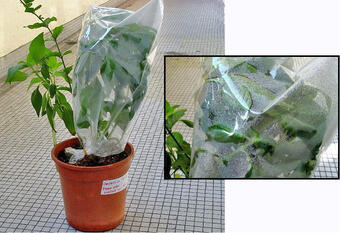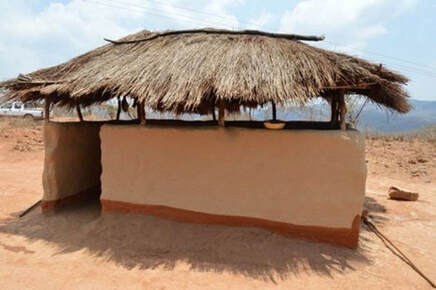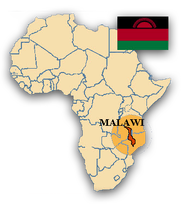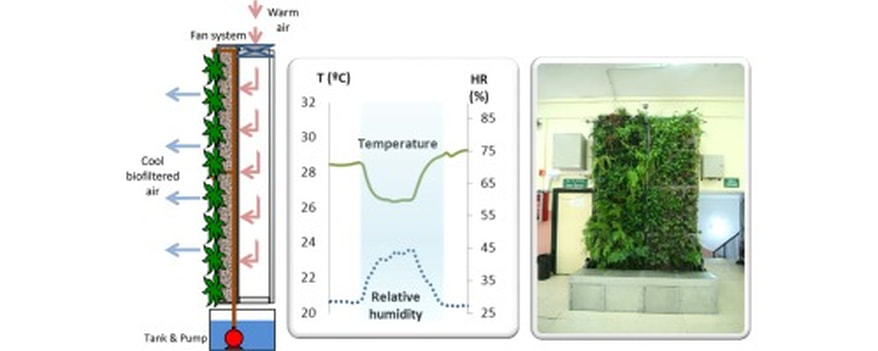Background

Transpiration vs. Evapotranspiration vs. Evaporative Cooling
"Transpiration is the process of water movement through a plant and its evaporation from aerial parts, such as leaves, stems and flowers. Water is necessary for plants but only a small amount of water taken up by the roots is used for growth and metabolism. The remaining 97–99.5% is lost by transpiration and guttation." (See image to the right, showing this process happening in a concentrate example.)
Evapotranspiration is "the process by which water is transferred from the land to the atmosphere by evaporation from the soil and other surfaces and by transpiration from plants." (so kiiiiinda/basically, both)
Evaporative Cooling is a "reduction in temperature resulting from the evaporation of a liquid, which removes latent heat from the surface from which evaporation takes place. This process is employed in industrial and domestic cooling systems, and is also the physical basis of sweating."
https://www.usgs.gov/special-topics/water-science-school/science/evapotranspiration-and-water-cycle
Dew Point vs. Humidity:
The Dew Point is the temperature where water vapor starts to condense out of the air (the temperature at which air becomes completely saturated). Above this temperature the moisture stays in the air.
The higher the dew point rises, the greater the amount of moisture in the air. This directly affects how "comfortable" it will feel outside. Many times, relative humidity can be misleading. For example, a temperature of 30 and a dew point of 30 will give you a relative humidity of 100%, but a temperature of 80 and a dew point of 60 produces a relative humidity of 50%. It would feel much more "humid" on the 80 degree day with 50% relative humidity than on the 30 degree day with a 100% relative humidity. This is because of the higher dew point.
So if you want a real judge of just how "dry" or "humid" it will feel outside, look at the dew point instead of the RH. The higher the dew point, the muggier it will feel.
General comfort levels USING DEW POINT that can be expected during the summer months:
less than or equal to 55: dry and comfortable
between 55 and 65: becoming "sticky" with muggy evenings
greater than or equal to 65: lots of moisture in the air, becoming oppressive
(https://www.weather.gov/arx/why_dewpoint_vs_humidity)
Absolute vs Relative Humidity
“In simple terms, the absolute humidity is the ratio of mass of water vapor to the mass of dry air. This is also referred to as the humidity ratio. The relative humidity, on the contrary, is the amount of water vapor that is present in the air, relative to the amount it could hold at that given temperature. Simply put, the relative humidity is a percentage of the amount of moisture the air could possibly hold.”
“Absolute humidity is totally independent of the temperature. It is purely about how much water is present in the air, regardless of the temperature. Relative humidity is totally dependent on the temperature meaning the value of relative humidity only specifies the moisture content of the air when accompanied by the temperature of the air.”
Read more: Difference Between Absolute and Relative Humidity | Difference Between http://www.differencebetween.net/science/nature/difference-between-absolute-and-relative-humidity/#ixzz7KJRV4OOD
“Warm air can possess more water vapor (moisture) than cold air, so with the same amount of absolute/specific humidity, air will have a HIGHER relative humidity if the air is cooler, and a LOWER relative humidity if the air is warmer.”
Simply, the absolute humidity is the ratio of mass of water vapor to the mass of dry air.
(https://www.weather.gov/lmk/humidity#:~:text=Warm%20air%20can%20possess%20more,if%20the%20air%20is%20warmer.)
"Transpiration is the process of water movement through a plant and its evaporation from aerial parts, such as leaves, stems and flowers. Water is necessary for plants but only a small amount of water taken up by the roots is used for growth and metabolism. The remaining 97–99.5% is lost by transpiration and guttation." (See image to the right, showing this process happening in a concentrate example.)
Evapotranspiration is "the process by which water is transferred from the land to the atmosphere by evaporation from the soil and other surfaces and by transpiration from plants." (so kiiiiinda/basically, both)
Evaporative Cooling is a "reduction in temperature resulting from the evaporation of a liquid, which removes latent heat from the surface from which evaporation takes place. This process is employed in industrial and domestic cooling systems, and is also the physical basis of sweating."
https://www.usgs.gov/special-topics/water-science-school/science/evapotranspiration-and-water-cycle
Dew Point vs. Humidity:
The Dew Point is the temperature where water vapor starts to condense out of the air (the temperature at which air becomes completely saturated). Above this temperature the moisture stays in the air.
The higher the dew point rises, the greater the amount of moisture in the air. This directly affects how "comfortable" it will feel outside. Many times, relative humidity can be misleading. For example, a temperature of 30 and a dew point of 30 will give you a relative humidity of 100%, but a temperature of 80 and a dew point of 60 produces a relative humidity of 50%. It would feel much more "humid" on the 80 degree day with 50% relative humidity than on the 30 degree day with a 100% relative humidity. This is because of the higher dew point.
So if you want a real judge of just how "dry" or "humid" it will feel outside, look at the dew point instead of the RH. The higher the dew point, the muggier it will feel.
General comfort levels USING DEW POINT that can be expected during the summer months:
less than or equal to 55: dry and comfortable
between 55 and 65: becoming "sticky" with muggy evenings
greater than or equal to 65: lots of moisture in the air, becoming oppressive
(https://www.weather.gov/arx/why_dewpoint_vs_humidity)
Absolute vs Relative Humidity
“In simple terms, the absolute humidity is the ratio of mass of water vapor to the mass of dry air. This is also referred to as the humidity ratio. The relative humidity, on the contrary, is the amount of water vapor that is present in the air, relative to the amount it could hold at that given temperature. Simply put, the relative humidity is a percentage of the amount of moisture the air could possibly hold.”
“Absolute humidity is totally independent of the temperature. It is purely about how much water is present in the air, regardless of the temperature. Relative humidity is totally dependent on the temperature meaning the value of relative humidity only specifies the moisture content of the air when accompanied by the temperature of the air.”
Read more: Difference Between Absolute and Relative Humidity | Difference Between http://www.differencebetween.net/science/nature/difference-between-absolute-and-relative-humidity/#ixzz7KJRV4OOD
“Warm air can possess more water vapor (moisture) than cold air, so with the same amount of absolute/specific humidity, air will have a HIGHER relative humidity if the air is cooler, and a LOWER relative humidity if the air is warmer.”
Simply, the absolute humidity is the ratio of mass of water vapor to the mass of dry air.
(https://www.weather.gov/lmk/humidity#:~:text=Warm%20air%20can%20possess%20more,if%20the%20air%20is%20warmer.)
Preliminarily Literature Review + Background on Topic:
In my research and literature review around the issue of the heat island effect, I read this paper that found in their study of relative humidity 'in a Mediterranean city" that "trees’ foliage increases the latent heat exchange through evaporative cooling by a process called evapotranspiration, making the air temperature cooler". While this study looked at the effects of introducing tree coverage over an exterior environment, I found the information still applicable and helpful in my understanding of the effects vegetation has on temperature and therefore relative humidity and thermal comfort.
(Jaafar, Lakkis, and Yeretzian 2022)
A study conducted in 2012, interested in "the cooling potential of an Indoor Living Wall using different substrates in a warm climate" found that in fact “the cooling effect of the living wall was proven, with an average reduction of 4°C over the room temperature though maximum decrements of 6°C have been observed in warmer conditions." They also found that "higher air humidity levels were experienced near the living wall, increasing the overall humidity in the room.” Given my previous research of relative humid, this means that since the humidity of the room was increased near the living wall, the temperature must have also decreased near the living wall suggesting that proximity to and/or the ratio of the vegetative surface to the overall volume of the room is an important consideration as well. (Fernández-Cañero, Urrestarazu, and Franco Salas 2012)
I was excited to read about this study from 2016 where, similar to my initial idea(s), they forced air through the green wall system as a filtration of sorts. "In an Active Living Wall (ALW), air is forced to pass through the vegetated wall to take advantage of their evaporative cooling potential as well as the capacity of these biological systems to purify air." This study noted that the implementation of ALWs facilitates air being "bio-filtered and humidified" within an indoor space, " thus potentially reducing ventilation requirements". I thought another interesting note from this was the qualification they made for the need of further study "to optimize the size of ALW systems according to the volume of air to be conditioned" was necessary following their studies. Lastly, they noted that if one was to reverse the air flow "to pass the vegetation layer from the outside to the inside of the ALW. This other configuration may allow some advantages as diverting the treated (cooled, biofiltered) air to the building HVAC system in order to reduce the volume of outdoor air that needs to be cooled and ultimately energy consumption”, which is really the topic that interests me most. I would like for my experiment to reveal the potential for fresh air intake through a vegetative filter such that overall building energy consumption is in turn reduced. (Pérez-Urrestarazu et al. 2016)
In my research and literature review around the issue of the heat island effect, I read this paper that found in their study of relative humidity 'in a Mediterranean city" that "trees’ foliage increases the latent heat exchange through evaporative cooling by a process called evapotranspiration, making the air temperature cooler". While this study looked at the effects of introducing tree coverage over an exterior environment, I found the information still applicable and helpful in my understanding of the effects vegetation has on temperature and therefore relative humidity and thermal comfort.
(Jaafar, Lakkis, and Yeretzian 2022)
A study conducted in 2012, interested in "the cooling potential of an Indoor Living Wall using different substrates in a warm climate" found that in fact “the cooling effect of the living wall was proven, with an average reduction of 4°C over the room temperature though maximum decrements of 6°C have been observed in warmer conditions." They also found that "higher air humidity levels were experienced near the living wall, increasing the overall humidity in the room.” Given my previous research of relative humid, this means that since the humidity of the room was increased near the living wall, the temperature must have also decreased near the living wall suggesting that proximity to and/or the ratio of the vegetative surface to the overall volume of the room is an important consideration as well. (Fernández-Cañero, Urrestarazu, and Franco Salas 2012)
I was excited to read about this study from 2016 where, similar to my initial idea(s), they forced air through the green wall system as a filtration of sorts. "In an Active Living Wall (ALW), air is forced to pass through the vegetated wall to take advantage of their evaporative cooling potential as well as the capacity of these biological systems to purify air." This study noted that the implementation of ALWs facilitates air being "bio-filtered and humidified" within an indoor space, " thus potentially reducing ventilation requirements". I thought another interesting note from this was the qualification they made for the need of further study "to optimize the size of ALW systems according to the volume of air to be conditioned" was necessary following their studies. Lastly, they noted that if one was to reverse the air flow "to pass the vegetation layer from the outside to the inside of the ALW. This other configuration may allow some advantages as diverting the treated (cooled, biofiltered) air to the building HVAC system in order to reduce the volume of outdoor air that needs to be cooled and ultimately energy consumption”, which is really the topic that interests me most. I would like for my experiment to reveal the potential for fresh air intake through a vegetative filter such that overall building energy consumption is in turn reduced. (Pérez-Urrestarazu et al. 2016)
Pérez-Urrestarazu, L., R. Fernández-Cañero, A. Franco, and G. Egea. 2016. “Influence of an Active Living Wall on Indoor Temperature and Humidity Conditions.” Ecological Engineering 90 (May): 120–24. https://doi.org/10.1016/j.ecoleng.2016.01.050
A result of lowered temperature swings over the course of a studied day by one group "indicate that the incorporation of a substantial quantity of plants in office buildings can lead to reduced building energy consumption and carbon emission rates, by allowing the temperature setpoint to be raised in the summer and lowered in the winter.” The study also found that the incorporation of plants in the studied office space "were not found to have a substantial effect on the temperature or humidity". Lastly from this study published in 2014, "it is important to note that the relative humidity (across the studied rooms) were relatively similar throughout the test sessions, regardless of the presence of plants... indicating that the evapotranspiration processes of the plants did not substantially increase the moisture content of the rooms.” (Mangone, Kurvers, and Luscuere 2014)
In a study published in 2020, concerned with potential increase in relative humidity (RH) with incorporation of 'vertical greening solutions', growing in popularity in built environments, the study found that “the RH (relative humidity) was not significantly elevated by vegetation except during warm afternoons in summer and winter” showing the dependence of relative humidity levels on temperature levels. "During warm afternoons, the external RH was significantly higher only behind the Hedera foliage compared to the bare ‘buildings’, 11% and 3.7%, summer and winter respectively. However, inside all vegetated ‘buildings’ the RH was at least 11% higher compared to the bare ‘buildings’ during summer. Yet, in winter the internal RH was 5.7% lower in the Hedera-covered compared to the bare ‘buildings’. Current building standards would prevent the transfer of external RH in this range internally, as the walls include protective layers such as damp-proof membranes.” (Thomsit-Ireland et al. 2020)
In a study published in 2020, concerned with potential increase in relative humidity (RH) with incorporation of 'vertical greening solutions', growing in popularity in built environments, the study found that “the RH (relative humidity) was not significantly elevated by vegetation except during warm afternoons in summer and winter” showing the dependence of relative humidity levels on temperature levels. "During warm afternoons, the external RH was significantly higher only behind the Hedera foliage compared to the bare ‘buildings’, 11% and 3.7%, summer and winter respectively. However, inside all vegetated ‘buildings’ the RH was at least 11% higher compared to the bare ‘buildings’ during summer. Yet, in winter the internal RH was 5.7% lower in the Hedera-covered compared to the bare ‘buildings’. Current building standards would prevent the transfer of external RH in this range internally, as the walls include protective layers such as damp-proof membranes.” (Thomsit-Ireland et al. 2020)
Sources
“Thatch Roofing.” Thatch Roofing - Designing Buildings, https://www.designingbuildings.co.uk/wiki/Thatch_roofing.
Fernández-Cañero, Rafael, Luis Pérez Urrestarazu, and Antonio Franco Salas. 2012. “Assessment of the Cooling Potential of an Indoor Living Wall Using Different Substrates in a Warm Climate.” Indoor and Built Environment 21 (5): 642–50. https://doi.org/10.1177/1420326X11420457.
Jaafar, Hasan, Issam Lakkis, and Aram Yeretzian. 2022. “Impact of Boundary Conditions in a Microclimate Model on Mitigation Strategies Affecting Temperature, Relative Humidity, and Wind Speed in a Mediterranean City.” Building and Environment 210 (February): 108712. https://doi.org/10.1016/j.buildenv.2021.108712.
Mangone, Giancarlo, S. R. Kurvers, and P. G. Luscuere. 2014. “Constructing Thermal Comfort: Investigating the Effect of Vegetation on Indoor Thermal Comfort through a Four Season Thermal Comfort Quasi-Experiment.” Building and Environment 81 (November): 410–26. https://doi.org/10.1016/j.buildenv.2014.07.019.
Pérez-Urrestarazu, L., R. Fernández-Cañero, A. Franco, and G. Egea. 2016. “Influence of an Active Living Wall on Indoor Temperature and Humidity Conditions.” Ecological Engineering 90 (May): 120–24. https://doi.org/10.1016/j.ecoleng.2016.01.050.
Thomsit-Ireland, Faye, Emmanuel A. Essah, Paul Hadley, and Tijana Blanuša. 2020. “The Impact of Green Facades and Vegetative Cover on the Temperature and Relative Humidity within Model Buildings.” Building and Environment 181 (August): 107009. https://doi.org/10.1016/j.buildenv.2020.107009.
Fernández-Cañero, Rafael, Luis Pérez Urrestarazu, and Antonio Franco Salas. 2012. “Assessment of the Cooling Potential of an Indoor Living Wall Using Different Substrates in a Warm Climate.” Indoor and Built Environment 21 (5): 642–50. https://doi.org/10.1177/1420326X11420457.
Jaafar, Hasan, Issam Lakkis, and Aram Yeretzian. 2022. “Impact of Boundary Conditions in a Microclimate Model on Mitigation Strategies Affecting Temperature, Relative Humidity, and Wind Speed in a Mediterranean City.” Building and Environment 210 (February): 108712. https://doi.org/10.1016/j.buildenv.2021.108712.
Mangone, Giancarlo, S. R. Kurvers, and P. G. Luscuere. 2014. “Constructing Thermal Comfort: Investigating the Effect of Vegetation on Indoor Thermal Comfort through a Four Season Thermal Comfort Quasi-Experiment.” Building and Environment 81 (November): 410–26. https://doi.org/10.1016/j.buildenv.2014.07.019.
Pérez-Urrestarazu, L., R. Fernández-Cañero, A. Franco, and G. Egea. 2016. “Influence of an Active Living Wall on Indoor Temperature and Humidity Conditions.” Ecological Engineering 90 (May): 120–24. https://doi.org/10.1016/j.ecoleng.2016.01.050.
Thomsit-Ireland, Faye, Emmanuel A. Essah, Paul Hadley, and Tijana Blanuša. 2020. “The Impact of Green Facades and Vegetative Cover on the Temperature and Relative Humidity within Model Buildings.” Building and Environment 181 (August): 107009. https://doi.org/10.1016/j.buildenv.2020.107009.



